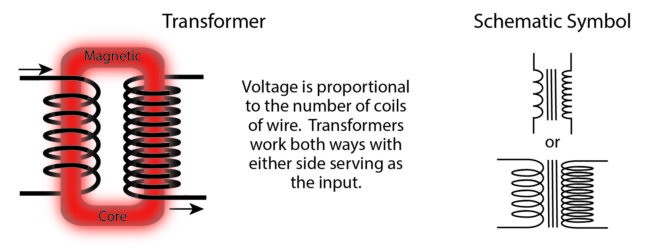Inductors and capacitors both provide short term storage of electrical energy but in different ways and with different goals. A capacitor physically stores electrons and acts as a source of voltage. An inductor stores electrical current in a magnetic field and acts as a source of current.

Although not present in all inductors, a core of magnetically conductive material is often introduced inside the coil of wire to increase its ability to develop and store a strong magnetic field. An inductor with this construction is often called a choke.
An inductor stores energy in a magnetic field which is created by a changing flow of current through the conductor. When the source of current flow changes, the magnetic field increases by absorbing energy or collapses releasing energy in an attempt to sustain a constant current flow through the inductor. In this way, the inductor serves as a source of current flow. Since this whole concept is a little hard to grasp, the following diagram shows the steps that an inductor goes through as electricity is cycled on and off.

A = Inductor in neutral state with no magnetic field.
B = When a voltage source is applied, the light bulb first glows brightly but then dims as the magnetic field is created in the inductor as the current flow through the inductor increases.
C = At the point of maximum magnetic field the light bulb glows dimly. Current flow through the inductor is limited by the internal resistance of the voltage source (a battery in this illustration). Note – Theoretically, the magnetic field around the inductor will continue to grow unimpeded to infinity if there is no external resistance to limit current flow – Think Big Bang?
D = When the voltage source is removed, the magnetic field around the inductor collapses and the light bulb at first glows brightly then goes out as the magnetic field is depleted.
E = Inductor in neutral state with no magnetic field.
Unlike a capacitor which stores electrons indefinitely, an inductor can not store current in a magnetic field in the long term without a source of voltage. Because of the short duration of the collapse of the magnetic field, inductors are most useful as described above at relatively high frequencies (think several thousand Hz and up).
The measure of inductance is the Henry. An inductance of one henry is present when an applied electric current that is changing at one amp per second results in a voltage of one volt across the inductor. Ratings may also include the voltage or current limitations of the device.
The principle of induction can also be employed in making a transformer to convert a varying voltage source from one voltage to another. A transformer consists of two inductors that are coupled by a magnetically conductive core. One inductor (coil of wire) is connected to an oscillating voltage source to produce an oscillating magnetic field. The oscillating magnetic field then acts to produce an oscillating voltage in the second coil of wire. FYI – Transformers do not work with Direct Current. Go Tesla!

Inductors, along with capacitors and resistors, are useful in designing circuits that either allow or prevent the passage of oscillating voltages at a specific frequency.
– JF –



 English
English Spanish
Spanish Chinese
Chinese Canada
Canada Mexico
Mexico United Kingdom
United Kingdom



